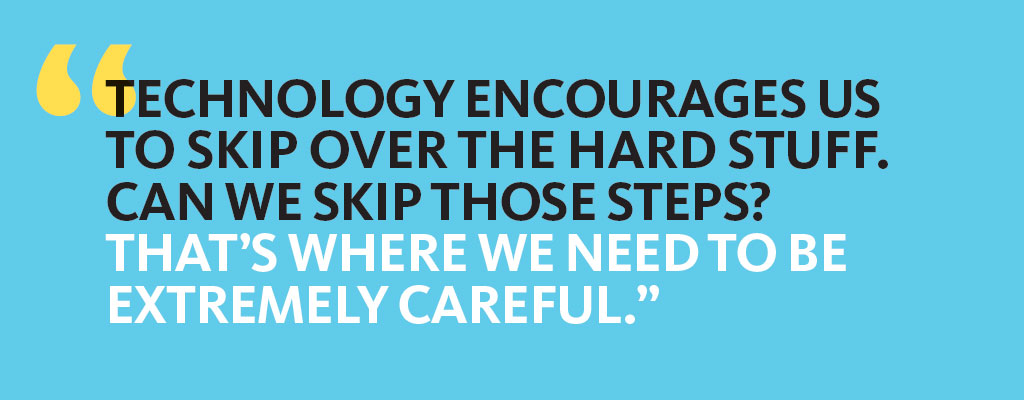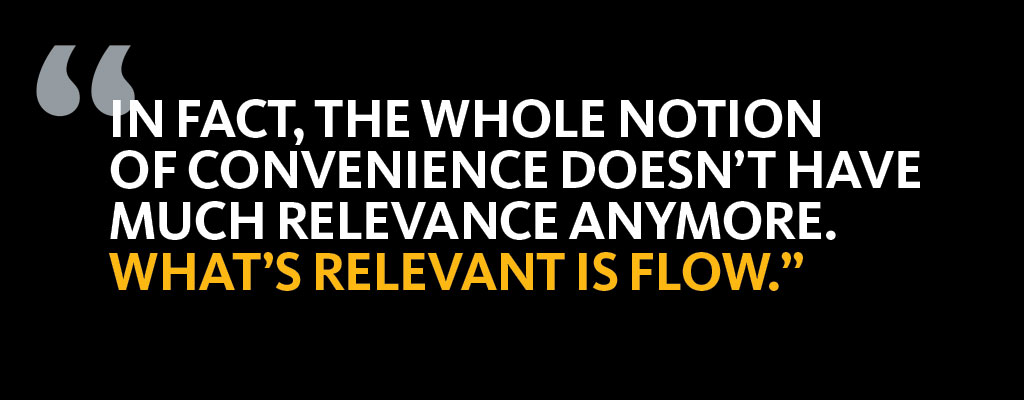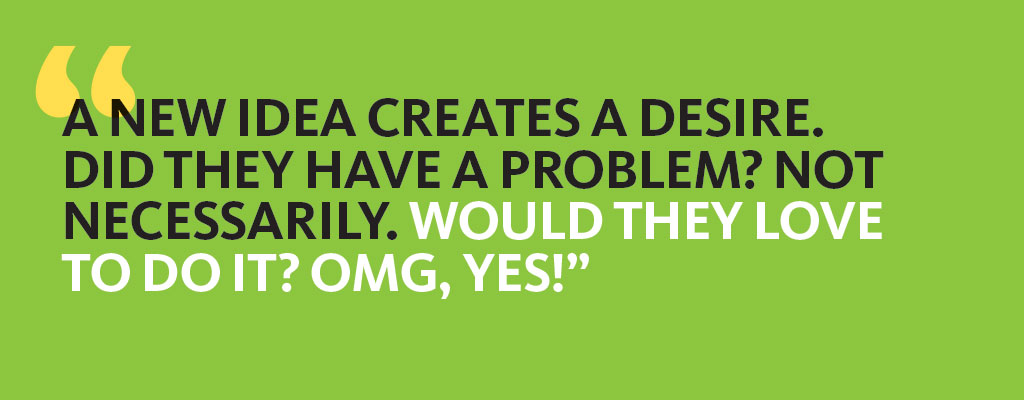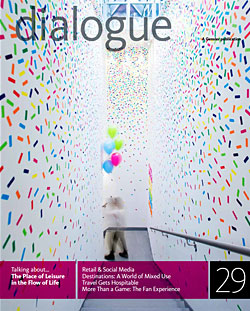Roundtable: Living the Transitional Lifestyle
As people embrace their iHumanity, categories like luxury come into question. Not everyone’s ready to exchange old for new, but the new is not to be denied. As brands, makers, and consumers try to finesse this transition, they’re asking, Where’s lifestyle headed next?
What does luxury mean today?
Kevin Roche: Luxury is a state of mind. It is very individual and personal, which makes it so elusive. Its complexity and diversity reflect the accessibility of information, how technology has influenced that accessibility, and how marketing communications has made more things accessible to more people, more readily. They’re better informed, and more visually intelligent.
How do you plan for a common thread of visual intelligence, for a luxury that is both global and also deeply personal?
KR: The common thread is that it has to be authentic, well designed, and executed without compromise. Real luxury comes from those authentic roots and ways of making. It’s the opposite of toxic, creeping, all-the-time sameness!
How does conscientious consumption impact the luxury market?
KR: Luxury has gone beyond the consumption of high-design products or experiences. It’s also very personal. There’s a whole industry of taking care of yourself physically, emotionally, and spiritually that has tapped this luxury way of thinking. Having a place where you have quiet, where you have solitude, is a luxury, whether it’s going to spas and retreats where you talk about diet, fitness, and well-being, or spiritual development and enhancement. As generations of consumers become better educated, their access to knowledge creates a bigger market for luxury—leading in turn to more products, more places, and more services. That has fueled luxury. I think health and wellness are part of this, as people become more aware. Being fit is a smart thing, and it requires a certain amount of awareness, even education, a certain amount of resources. That puts health and wellness into the luxury category.
Some consider luxury to be frivolous, even irresponsible. What’s your view?
KR: You must keep it in perspective and understand that luxury is a privilege. The luxury industry creates jobs, contributes to social enhancement, helps families send kids to school, provides healthcare, and takes care of aging parents and grandparents. In Siem Reap, Cambodia, we are building a new Galleria that will employ 400 people in a market where jobs with benefits are very much in demand. We will educate and train the local staff in retailing and in the service industry. We’re teaching language skills. We’re creating 400 good jobs in a place where most people earn the equivalent of a few dollars a week—a place where most families are just subsisting and education is hard to obtain. We’ll pay our employees more in a month than some might earn in a year. That will build houses, educate the youth, and pay for healthcare. We’re also doing this in Vietnam, with a focus on cultural destinations, and in other new markets around the world.
Do you translate everything you do behind the scenes into a narrative of authenticity? How do you get clients to recognize that something is luxurious?
KR: There are things you don’t have to translate. They’re more luxurious if you don’t try. They just are, and you understand, you feel it. It’s more emotive, and you just get it. You’re supposed to recognize luxury, but this requires a degree of grounding. You don’t need a Ph.D., but you have to be educated in a visual way, in a well-rounded way—aware of arts of all types, of the humanities, and sensitive to the details. That knowledge gives luxury a broader meaning.
I live a pretty luxurious lifestyle, and I like it, but one of the happiest times of my life was living in Paris in an apartment not much bigger than a room. It was a beautiful place, but it was tiny. It had no lift. I had to climb up four flights. I went to the market with my canvas bag. I could walk to the museums, to little neighborhood restaurants and bakeries. Not everyone in Paris lives like that. For me, it was a luxury.
If we could give luxury to everybody, would it still be luxury?
KR: The fact that it’s not accessible is often what makes luxury feel like luxury, but part of its elusiveness is that it’s also about having access to something desirable. Consider how Steve Jobs revolutionized the music industry, for example. Being able to hear your playlist anywhere, anytime, through the cloud has improved the quality of my life. It makes me feel better, makes me happy.
That’s a real luxury, yet it’s something that’s widely available. So if we’re talking about affordable mass housing or inexpensive carbon-free cars, they will need to be designed with the same care and attention that Steve Jobs displayed when he transformed the music industry. Design is at the center of that. When you have access to something so desirable, accessible, and beautifully thought out, you understand it as luxury.
I come back to education, to a humanity that’s growing steadily more aware, more dialed into these things. If that’s not there, then it’s not luxury; it’s just consumption.
How is technology helping us to be better humans?
Carla Diana: We are becoming more individualized. One thing that is changing our lives is the affordability of sensors, which used to be very expensive and difficult to use. Now they’re widely available and cost $1.99. We’re seeing more companies that are using them to create new consumer products that translate sensor inputs into something meaningful. The Apple Watch tracks heart rate. I don’t know if that’s something that anyone other than athletes and medical professionals really thought about 10 or 15 years ago. Now I can glance at my watch and tell you. Even the phrase “resting heart rate” has entered the vernacular. That type of self-knowledge is really good for the world in a lot of ways.
Technology can also enable you to lead a more flexible life. If telepresence lets you have a real experience with someone else, or if robots can take over the repetitive parts of work, then your workday may be shorter and you’ll have more time to be a human being. A lot of people envision a future with dog-walking robots, but I’m wondering if I can get a robot to comb through the spreadsheets I have to analyze so I can actually take my dog for a walk.
Will outsourcing to technology make us dumber?
CD: Everyone talks about self-driving cars. It’s not hard to picture that future. The hours that Americans spend driving in traffic are real drudgery. That isn’t something we need in our lives. But technology also encourages us to skip over the hard stuff. I force myself to do mental tasks, like memorizing. I make myself do addition in my head because I feel that I’m losing the ability to do math—something I loved as a kid. At the University of Pennsylvania, where I teach, there are Ph.D. students who are experts in artificial intelligence. They got there by doing arithmetic as kids, and then doing computer programming. Can we skip those steps? That’s where we need to be extremely careful.
Are our analog lives too dependent on digital supports?
CD: Analog versus digital isn’t a black-and-white thing. I love to bike ride. I don’t think that the existence of the self-driving car means that I won’t still do this or that people will stop bringing bicycles into their lives. The future could be a bike with GPS built into it, so the handlebars vibrate and give me turn-by-turn directions. I’m still out there biking, getting the visceral parts of the experience that I want.

What does “responsive technology” mean to you?
CD: Right now, the philosophy about responsive technology is focused on personal devices. This is because we don’t have such a responsive environment. A group in New York, Breakfast, does a lot of technology experiments. They have a concept for a dynamic street sign. In their vision, you’d push a button to show you where the coffeehouses are, where the bike runs are, where the office spaces are—depending on your needs. The street sign itself would change dynamically so it could point in many different directions.
That’s a philosophy about responsive technology that expects the environment to change physically depending on what you ask of it. The response might take the form of augmented reality—environments where invisible cues are built into the three-dimensional space. Or the space might morph in some way—the doors opening and closing, for example, depending on what you need or where you’re going. These are two ends of a continuum of possible responses.
Is this responsiveness a luxury?
CD: Luxury boils down to control. We have this human illusion, feeling that we can control the world when we really can’t. I walk into a room, switch on the light, and adjust the temperature. I take this control for granted, but something could happen at any moment that could take it away. So it’s an illusion, but we revel in it. I think technology will give us more of that.
I see information becoming absorbed into our environment—a recipe we can summon up at the kitchen counter, for example, just by asking for it. It will arrive when we need it, in the right place and form. It won’t come through mobile devices. They drive us bananas because they provide “everything always”—too much at once. The future will run on a different philosophy.
As a futurist who considers how human nature and technology intersect, what big changes to that intersection have you observed?
Karina Marshall: The typical, conventional structure of a day just doesn’t exist now. It’s being disrupted from every angle. We think of leisure occurring after work hours or on vacation, but it can happen at any time, at any moment. In the past 10 years, there’s been a lot of conversation about mixed- use spaces. We’re moving beyond that as work and leisure converge. We’re remixing our days. Morning Gloryville’s drug- and alcohol-free rave parties help urbanites wake up in cities around the world. There’s a boom in outdoor sports in Korea, and now there’s a word for it, 'naports'—people beating the summer heat by playing sports at night. So we have to design cities and settings to support that fluidity.
How does blending work with leisure influence daily life? Can we still turn it off?
KM: Being able to turn it off is not something that most people can afford to do. It’s interesting to think of how technology gives us a little bit more time here and there, allows us to do more; but the more that we do, the more expectation there is that we’ll do more and more and more.
In today’s anxiety-driven, busyness- as-status culture, can we elevate rest and play? Leisure will have to come together with our culture of accomplishment. One way this is happening is through bite-size leisure moments and experiences. But we may see more leisure that is tied to personal measures of success, like learning a new language or exploring a place that’s off the map, versus buying some shiny new thing or going somewhere fancy.
Will responsive spaces and products help us out?
KM: The way that physical spaces can help encourage behavior is fascinating. I like the social experiment of using musical stairs to encourage people to take the stairs—as you walk up or down them, you can make music. Another example is how Google influences its employees’ eating habits by fine-tuning the food environment. It can be low-tech or high-tech. With artificial intelligence, AI, you’re connected to these personal systems that know everything about you. Imagine now that the spaces you’re in or move through are interacting with AI elements to guide you—guide your behavior and even change it. That could be quite powerful.

This is a big question in healthcare too: Can technology help save us from ourselves? It will have a massive impact, but only if it can be integrated. We have apps and devices that monitor our activities. When will they start suggesting solutions, actually changing our behavior? That’s going to be really critical. Let’s say my monitor finds that I’ve had my fair share of sugar for the day, so it locks me out of my pantry. Or it sees that I’ve been sitting too long, so it turns off the TV. Or maybe it books a car to take me to a spin class, knowing from my schedule that I’ve got enough time to take it and knowing from my heart rate that I need to get moving.
It’s exciting what AI and these personal technologies can do to free up space in our minds to focus on what we care about. There’s a reason why the app that tracks and shares your meditation is called “Headspace.”
Is having that space a luxury? Time feels like a scarce resource.
KM: It’s interesting that time used to be thought of as the most critical resource—everything was about saving us time. But once we had the time to do more, we found that we didn’t have the energy to make full use of it, so all these energy-enhancing tools came on the marketplace. This got us the culture of busyness that we’re all deploring. So the next resource we’re after is mind space, headspace. There’s already an app for that!
Convenience used to be about making things faster and easier, but I don’t think that’s the case now. In fact, the whole notion of convenience doesn’t have any real relevance to our world anymore. What’s relevant is the concept of flow—a flow that facilitates consumers’ lives.
To facilitate the right flow, the AI will need to know the context that I’m living through on that particular day, that specific moment in time: where I’ve been and where my schedule says I’m headed, what the weather is and what it’s forecast to be, what I ate, what my fitness profile looks like. The AI will need to take all this information and its unfolding contexts—who I am, where I am, what I’m doing, understood in a much more dynamic way. It has to run with me.
Your title suggests an untamed beast in need of gentle handling. Can you elaborate?
Tatjana Dzambazova: One of the biggest impediments to technology adoption is the fear of change. There are two ways to make technology or software. The first is that you have a known group of people or an industry with a certain problem, and you find the solution. Whispering is needed in such cases, when you’re offering new ways of doing old things. You have to be empathetic about their fears and, at the same time, excite them about the opportunities these new ways offer.
The second approach is that you see scientific or technological advancements, you connect the dots, and you come up with and new idea for something that people never did before. Did they have a problem? Not necessarily. Instead, you’re creating a desire. Would they love to do it? Oh my God, yes!

Let’s go back to the untamed beast. Is technology always beneficial?
TD: My opinion is bipolar. How technology impacts our lives has a very dichotomous nature. On one hand, we live in an era of fantastic technological advancements that enable us to be connected, to be aware of what is going on, to have fundamentally new experiences, and to do unbelievable things. But those very same tools, in the hands of the dark side of people, can also create a lot of damage, unfortunately.
I’m often asked if smart devices are good or bad for kids. Is a knife a good tool or a bad tool? In the hands of a cook, a knife can make a great meal. An artist can use it to carve a beautiful sculpture. But a murderer can kill someone with it, right? Technology is just a tool. What we make with it is up to us—it reflects our values and our humanity.
You’re working on Memento, a product that makes 3D models of almost anything from 2D photos. What prompted its development?
TD: Behind Memento are two new concepts. One is “Rip, Fix, Burn”: you rip the original, fix it, mix it, and then re-burn it back into the real world using 3D printing or computer numerical control—CNC—machines. The other is “Rip, Mix, Learn”: you rip the original, fix it, mix it, re-burn it, and then use it pedagogically so people can learn from it.
My team and I have been working on democratizing the process of digitizing the analog world. We are applying Memento to the digital archiving of anything that is in museums, of any scientific artifacts. You can make 3D-printed or CNC-machined replicas that allow you to teach in a much more tactile way. An example is the paleontologist Dr. Louise Leakey, who is digitizing the entire fossil collection of three generations of her family’s discoveries in Kenya and Tanzania. This will make it possible not only to learn about our ancestors and our origins online with the digitized fossils, but also to download and 3D print skulls and other fossils for use in classrooms and in hands-on learning. We also have a huge opportunity to preserve our natural heritage. For example, we can capture coral reefs and document their change over time. We are also creating replicas of rare tortoises to distract the ravens that threaten them with extinction.
Will this sate our desire to see or own the originals? What happens to exclusivity?
TD: The exclusivity we associate with luxury items is usually about their uniqueness, their being made from rare or precious materials, and the artist or maker’s interest in pushing the limits of what was possible given the technology of that time. That is often only available to those with the money to commission it. This is the exact opposite.
When the Smithsonian set out to digitize its collections, 98 percent of it was not on display because there isn’t enough space. By digitizing it and putting it online, the Smithsonian makes the collections available in their entirety both to its visitors and to the many, many more who want to learn from them, whether they visit or not.
Having a digital replica of an original doesn’t sate your desire to see the real thing, but you can learn from it. And the digital replicas can be augmented with information. It’s not just a curator or docent talking. You can access video and cross-referencing to get the whole story of where the real thing came from, how it was made, and where it fits in human history.
Nothing replaces the originals, but people lose them and sometimes destroy them. Memento and the digi-tization projects it enables are our collective backup drive.
Eva Hagberg Fisher is a Bay Area writer; the author of two design books, both published by Monacelli; and a contributor to Metropolis, Wallpaper, and other publications.

